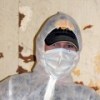(Spoilers below!)
For Walking Dead fans and readers of this blog, you probably know why I was all excited about some of the plot elements that have been included thus far this season: possible zoonotic disease, and in particular, a potential influenza outbreak that may have originated in pigs. I muse about this and other infections in an article for Slate.com, and will have additional thoughts about zombies and infectious disease more generally in the coming days.
See also:
Part II: ineffective treatments and how not to survive the apocalypse
More like this
Because this week is really hectic, I just want to follow up on this post I wrote about MRSA.
Chronic infection is, in a way, the new emerging infectious disea
Thankfully for the readers, most of the scientific literature I read doesn't make it into this blog. But one paper about a comparative drug trial had some very interesting results. In short, obesity and smoking are significant risk factors for post-operative infections.
Knock knock.
Whos there?
Not XMRV in African blood donors or HIV/AIDS patients.

What about zombies as walking carrion?
I linked that very article at the end of the Slate story. Generally I agree with that position,but it presupposes that they decay as normal people do. Some zombie stories (such as "Zombie autopsies") have come up with some creative ways to keep the zombies more "alive" for a longer period of time. Plus, as I mention, there's also the possible risk to animals from a zombie pathogen that could jump species.
First is physics, before biology, From whence the energy to animate? Can't defy thermodynamics.
Second, the zombies themselves are a problem for the Army Corps. of Engineers. The REAL threat in the zombie apocalypse is other humans. Iterated prisoners' dilemma: We cooperate to survive, share resources, until that is, someone cheats...